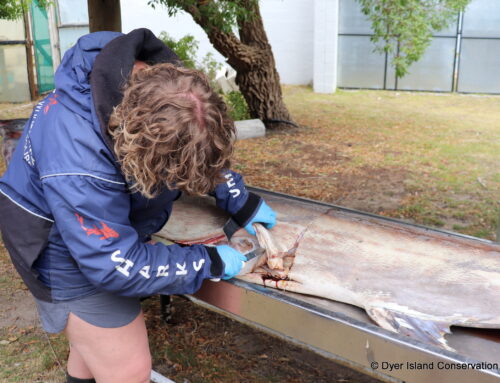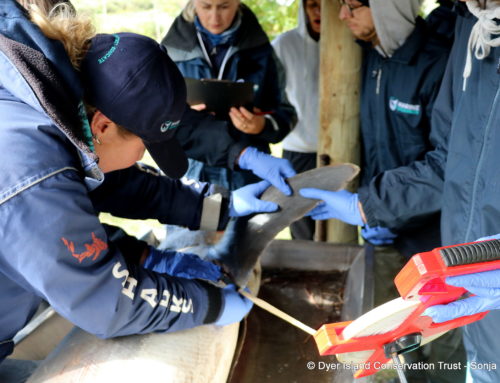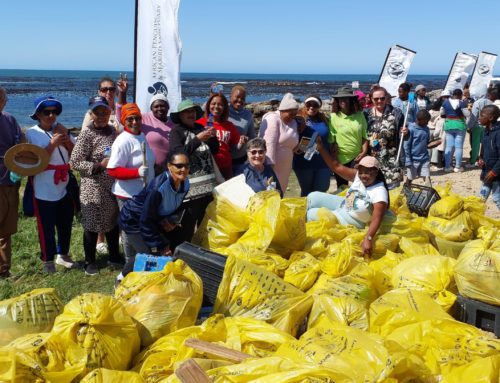Observations and wound healings
December 10, 2009 by dyertrust
by DICTs Marine Biologist Alison Towner
Early November saw our supervisors,Prof. Les Underhilland Dr Malcolm Smale here for a weekend to go over the projects finer aspects and planning. Malcolms expertise in the project is extremely beneficial and he was full of ideas as to how, why, when, and what else we should look at with the white sharks in the tracking area. Les- renowned for being a statistical genius gave some great insight on how best to analyse and collect data- along with incorporating oceanographic parameters into the picture. Together they really are an encouraging team and we very much look forward to their input throughout the project! We await word from the University on the go ahead.
SHARKS
But most importantly what of the sharks. November has been a great month for shark sightings, even though there was some strong wind in the first week. The water temperature increased to 17 C, the highest temperature recorded all year. The shallows are very busy and its always so fascinating to see how many individuals crowd and patrol such a small area of coastline. On various occasions this month we launched the Dyer Island Conservation Trusts new research vessel Lwazi and patrolled the shallows to make observations on the sharks movements. Interestingly the sharks seem very unresponsive- and distracted. They did not respond to a decoy after various attempts. Over 20 individual sharks were observed in the shallows on the 20th of November. A gyrocopter took to the air- working with us on the 27th and filmed from above. Its stunning to see just how much the dark silhouettes of the sharks stand out on the sandy bottom and also just how close to the beach they get. The aerial footage revealed some really interesting interactions between sharks too. At the same time- talking to the local fishermen in Kleinbaai revealed some excellent Chokka and Geelbek catches in an area very close to where the sharks were patrolling. On the second week of November we observed tiny bottle nose dolphins- no adults with them- cruising just next to white sharks along the beach. It seemed as if the sharks were circling the quick and agile little dolphins- then the dolphins disappeared. Similarly the indo pacific humpback dolphins have been observed in the bay again on various occasions.
As usual we recognised quite a few familiar fins during November- with shark activity very high all through the month. Gill was our first familiar shark to arrive. She is a large (3.2m) female we first named and identified in September 2007. Since then she has been re-sighted at Dyer Island (2008) and on numerous occasions this month. Her distinguishing feature is her Orions belt shaped pigmentation on the right of her dorsal fin. This shark also has a real personality and always comes across as very relaxed.
Another familiar fin this month is Wolfgang -a small female shark that Oli (our other marine biologist) named and identified in Mossel Bay. On arrival in Gansbaai he immediately recognised her and matched her dorsal ID. Wolfgang (named after a German videographer) has a small white pigmentation spot on the right of her dorsal and is a feisty shark- often rushing about. Moony was the third distinctive re-sight and arrived at the end of November. This shark was last seen at Dyer Island in July 2008. She has distinctive crescent half moon shape on the right of her dorsal and a very inquisitive nature. She loves to pass by the cage very slowly indeed- and always seems to turn with her belly angled towards the surface- stunning shark.
WOUND HEALING
Finally the most exciting re-sight of the month was Prop. This very special female shark was last observed at the beginning of the year and documented in November 2008. Sadly she had a chronic propeller injury on her ventral surfacejust between her head and dorsal fin. The injury we estimated was very close in depth to her vertebrae. It was sustained from a recreational vessel in the bay who relayed the incident immediately afterwards. Every opportunity to document her wound was utilised via underwater videography and surface photographs during her stay. Prop returned during the second week of November this year and was hardly recognisable. Her wound had completely healed and there was no raised scar tissue or clear indication there ever was a chronic wound! On close inspection of the healed wound it is clear to see these sharks have an incredible healing ability and rate. This is a topic we are now busy compiling a research paper on- to compare the white sharks healing to other animal taxa. This is an interesting topic and one that very little baseline research has been focused around it.
Many sharks have been observed with bite marks on their bodies this month- the majority of these bite marks are from smaller mouths. One theory is the possibility of bull seals. There are many of them around Geyser rock now and these large seals are known for their aggression and ability to inflict a bite on an opposing animal. There have been numerous predations documented this summer season in Joubertsdam. It seems that the sharks will readily go for a seal if it is in the shallows area. Up at Geyser rock the young of the year cape fur seal pups are battling with getting swept off the rocks. At this young phase they are very weak swimmers and often tire out and drown.
FUNDING
You can now purchase a block of research area on the web site (click here). You will receive a certificate of recognition for your support and be listed as ashark supporter. Makes a great and unusual gift for the nature lovers out there.
Support is growing. Any potential corporate sponsors can please get in touch with me for a formal proposal.
Thanks to all for the support!




